Swiss Meringue Buttercream Recipe
This easy Swiss meringue buttercream recipe is an absolute dream. It is creamy, smooth, not-too-sweet, and whips up light, airy, and luscious. A perfect accompaniment to cakes and cupcakes!
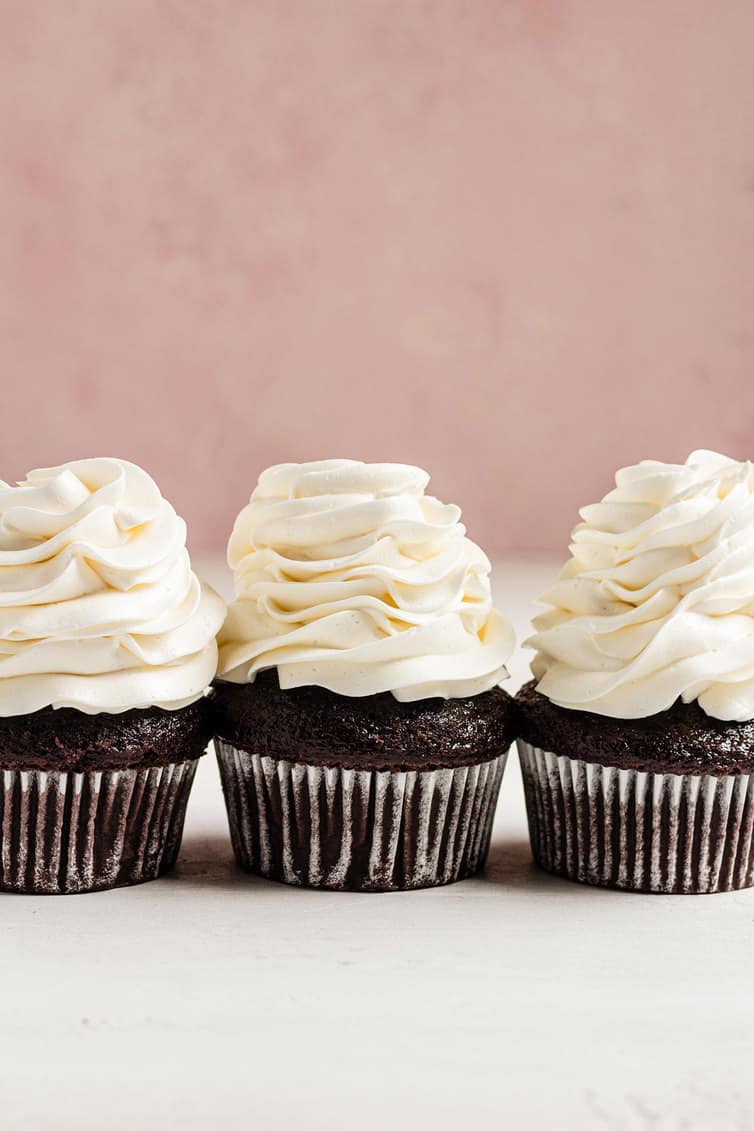
If you’ve never had it, Swiss meringue buttercream is built upon a meringue base and whips into an ultra-creamy, super-smooth, light, and airy frosting that is incredibly easy to work with. It is not nearly as sweet as traditional American buttercream frostings, which is why so many people love it.
You only need five simple ingredients (I bet you have them all in your house right now!) to pull this together and while many (including myself) have been intimidated by Swiss meringue in the past, I’m here to break it all down for you with loads of tips so that you can master Swiss meringue buttercream once and for all. Let’s do this!
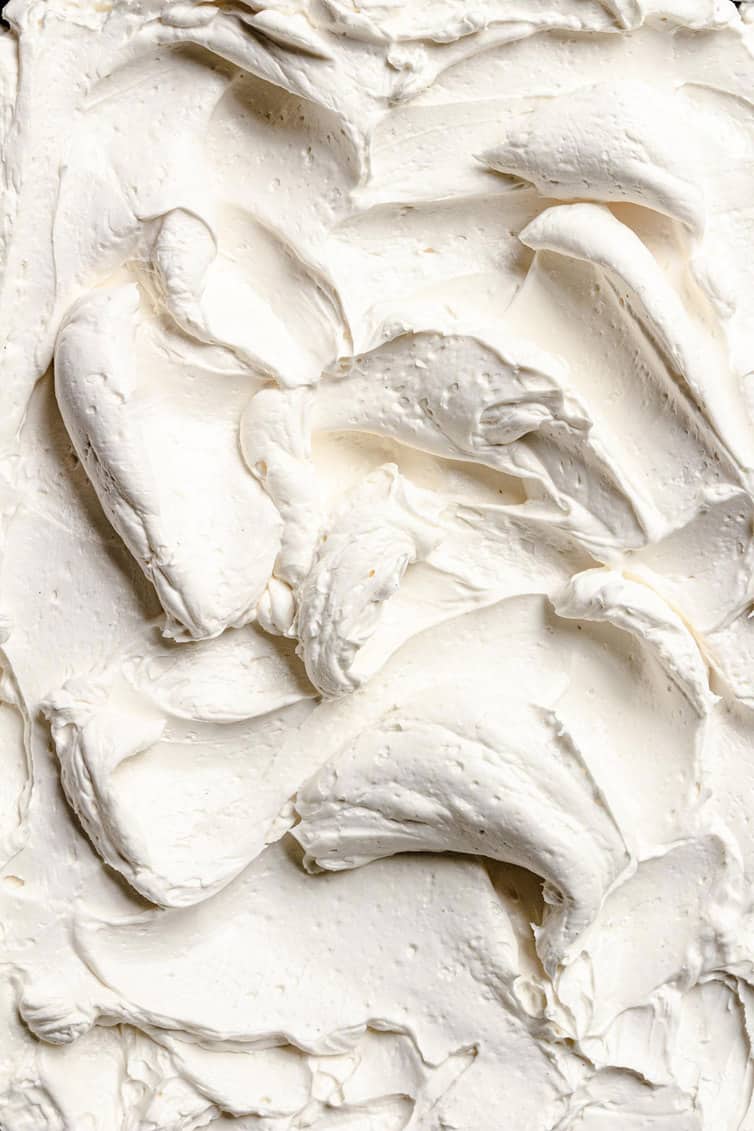
What is Swiss meringue buttercream?
Ahhh, Swiss meringue buttercream, or SMBC as it is so often referred, is an absolute dream. It’s made by heating egg whites and sugar together, then whipping the mixture into a meringue. Butter is then added and whipped some more until an incredibly light and silky smooth frosting is achieved.
More stable than whipped cream, less sweet than traditional American buttercream
How is it different from Italian meringue buttercream and American buttercream?
Swiss meringue buttercream and Italian meringue buttercream are very similar, as both are meringue-based. However, Italian meringue buttercream is more stable because it adds the extra step of drizzling a boiled sugar syrup into the whipped egg whites.
American buttercream, meanwhile, is created by whipping together butter and powdered sugar. It is significantly sweeter than the meringue-style frostings.
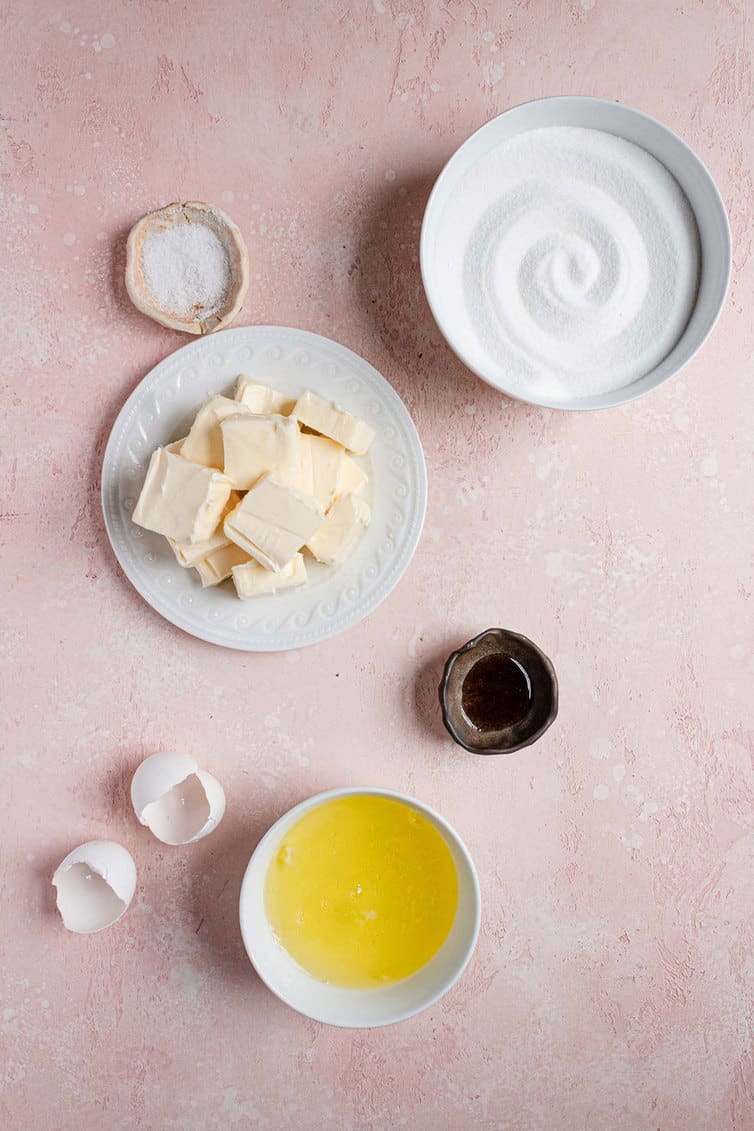
The Ingredients
We only need a handful of ingredients to make this incredible buttercream, so let’s run through them quickly:
- Egg whites – these get heated to 160 degrees F to ensure they are safe to consume, so no worries about raw eggs!
- Sugar – Regular white granulated sugar.
- Butter – Use your favorite unsalted butter.
- Vanilla extract – The real deal, never imitation, for maximum flavor!
- Salt – To balance out all of the flavors.
How to make Swiss meringue buttercream
This process isn’t very difficult, but it does take longer than a traditional American buttercream recipe; about 30 to 40 minutes is all you’ll need.
- Heat egg whites and sugar – Use an instant-read thermometer to heat the egg whites and sugar to 160 degrees F. Alternately, you can feel a bit of the mixture between your fingers (be careful, it’s hot!) to ensure that the sugar has dissolved.
- Whip it to a meringue – Using a whisk attachment, whip the egg and sugar mixture until stiff peaks form and the mixture and the bowl are no longer warm to the touch.
- Add the butter – Once you have stiff peaks and nothing is warm, begin adding the butter a piece at a time until it has all been incorporated.
- Add the butter and salt and whip! – Add the butter, salt, any other flavorings or colors, then continue mixing the buttercream until it is light and fluffy. You cannot overbeat Swiss meringue buttercream, so keep going until you get that light and fluffy consistency.
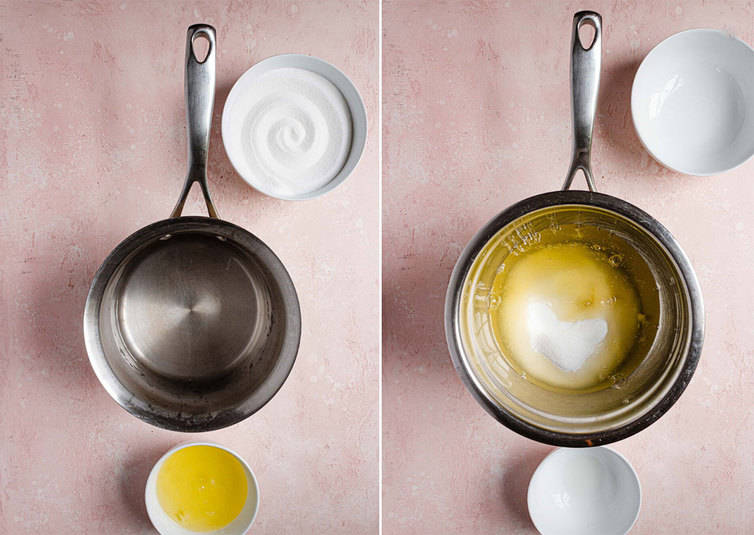
Tools
We don’t need much, but this is the equipment we’ll be using:
- Small saucepan – You’ll fill this with an inch or two of water to create an indirect heat source (or double-boiler) for heating the eggs and sugar.
- Heatproof bowl – A metal mixing bowl is what you want to use, and if you have a stand mixer you’ll save yourself a dish to wash if you use your mixer bowl for this step.
- Instant-read thermometer – While you can check the egg and sugar mixture with your fingers, using an instant-read thermometer is safer and more accurate.
- Electric mixer – While you can make this by hand, it will take a LOT of elbow grease a significant amount of time. If you have a stand mixer, absolutely use that; if not, a hand mixer will work, as well, but may take a bit longer.
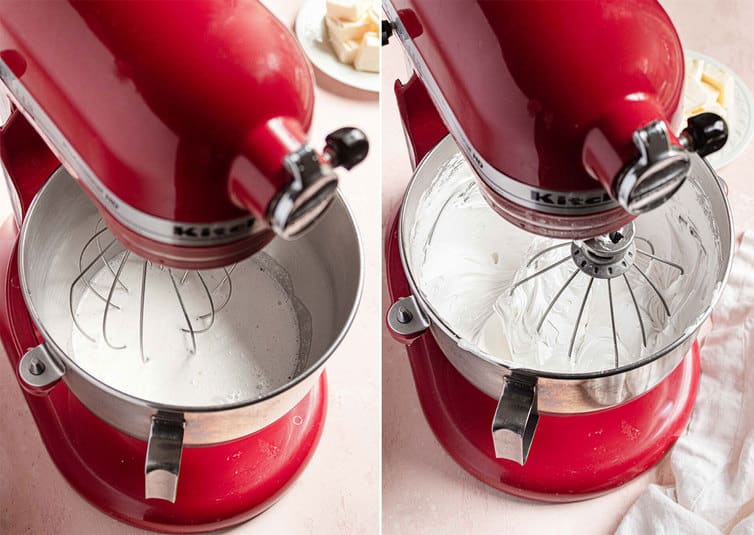
Troubleshooting
These are some of the common issues people encounter when making Swiss meringue buttercream, let’s learn how to fix them:
- No stiff peaks – In this case, prevention is the best medicine. When separating. your eggs, be sure that not a single drop of egg yolk gets into your whites or no matter how hard or how long you mix them, you just will not be able to achieve stiff peaks. If you’re sure that’s not the reason, pop the bowl in the refrigerator for 10 minutes and then try again. Usually, a cool-down can help.
- Frosting runny or won’t thicken – This is always due to heat. Either the meringue was still too warm, the butter became too warm while sitting out, or the ambient temperature in your kitchen is on the warm side. To remedy this, place the bowl in the refrigerator for 15 to 20 minutes, then whip again for 3 to 4 minutes and it should become thick and luscious. Return to the refrigerator and whip again if necessary.
- Frosting “breaks” or becomes curdled – In this case, the mixture is a bit too cool. The meringue may have cooled off too much while whipping, the butter was still too cool, or the kitchen is chillier than usual. To fix this, place the mixing bowl back over a saucepan of simmering water until you see the edges begin to melt. Place it back on the mixer with the whisk attachment, start on low speed, then gradually increase to medium-high and whip for 3 to 4 minutes. Repeat as necessary.
The biggest takeaway: be patient! Most of these issues are resolved by just mixing a little longer, or refrigerating and then mixing a little longer. It will come together! :)
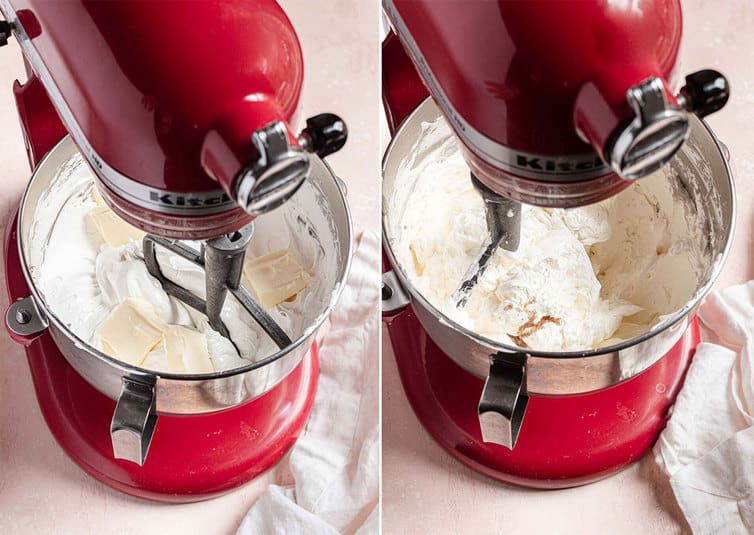
Recipe Tips & Notes
- Does SMBC harden? No, this type of buttercream will not form a “crust” as traditional American buttercream does. You can use this frosting for piping detail, filling cakes or cookies, and can even be used underneath fondant.
- How does it hold up in the heat? Like most butter-based frostings, this is fine at room temperature but will begin to get quite soft once you hit 80 degrees or so, and once you get much warmer than that, it can melt.
- More Flavors – I recommend keeping 1 teaspoon of the vanilla and then swapping out the other teaspoon for another extract flavor, if you desire.
- Chocolate Swiss Meringue Buttercream – To make a chocolate version, I use the same method from my favorite chocolate frosting – melt and cool 8 ounces of semisweet chocolate, then beat it into the buttercream when you add the vanilla and salt.
- Coloring the Frosting – Tinting this buttercream is easy! I recommend gel food coloring always so as not to introduce too much extra liquid (I use and recommend this AmeriColor soft gel color set); add it on low speed after you beat in the vanilla and salt.
- Make-Ahead and Storage Instructions – You can keep the frosting at room temperature for a few. hours after making it before using it. After that, it can be refrigerated in an airtight container for up to 1 week; be sure to re-whip before using it to get it back to that silky consistency. Baked goods with Swiss meringue buttercream can be left at room temperature, covered, for up to 2 days.
- Freezing Instructions – Swiss meringue buttercream can be frozen in an airtight container for up to 6 months. Thaw overnight in the refrigerator then re-whip to achieve a smooth consistency.
- Leftover Egg Yolks – If you’re wondering how to use up all of those leftover egg yolks, might I suggest some homemade ice cream, creme brulee, butterscotch pudding, or challah French toast?
How to Use Swiss Meringue Buttercream
This is such an incredibly versatile frosting and could be used for nearly anything! Here are some ideas to get you started:
- Use it to fill and frost cakes like yellow cake, angel food cake, chocolate cake, or devil’s food cake.
- Pipe it (or slather it!) on your favorite cupcakes (chocolate cupcakes are my favorite, but any of my cupcake recipes would be great).
- Fill gobs (aka whoopie pies) with it!
- If you make macarons, you can use this as a filling.
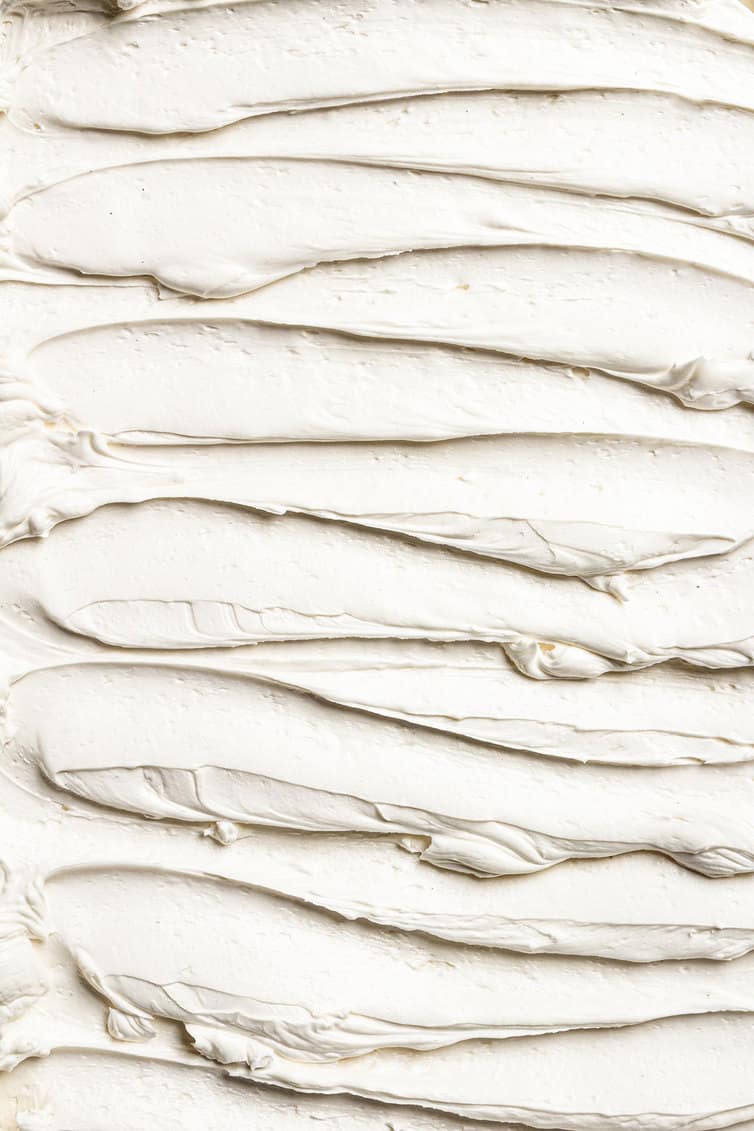
Watch the Recipe Video:
If you make this recipe and love it, I would so appreciate it if you would take a moment to leave a rating below. Thank you so much! ❤️️

Swiss Meringue Buttercream
Ingredients
- 6 egg whites
- 2 cups granulated sugar
- 2 cups unsalted butter, at cool room temperature and cut into tablespoon-size pieces
- 2 teaspoons vanilla extract
- Pinch salt
Instructions
- Place the egg whites in a heatproof mixing bowl (the bowl of your stand mixer would be ideal, but another heatproof bowl will work). Fill a medium saucepan with 1 to 2 inches of water and place over medium-low heat for a slow simmer.
- Add the sugar and whisk together. Place the bowl over the saucepan and whisk constantly until the sugar is completely dissolved and the mixture reaches 160 degrees F on an instant-read thermometer. This can take anywhere from a few minutes up to 10 minutes.
- Remove the bowl from the saucepan and place on your stand mixer fitted with a whisk attachment (you can also use a hand mixer if that’s all you have). Whip on medium-high speed until stiff, glossy peaks form, about 10 to 15 minutes. (If you have stiff peaks but your bowl or the meringue is still warm to the touch, place the bowl in the refrigerator for 10 minutes or so to cool down before you add the butter.)
- Switch to the paddle attachment and beat on medium-high speed while adding the butter one piece at a time, waiting for each piece to fully incorporate before adding the next.
- Once all of the butter has been incorporated, reduce the mixer speed to medium and add the vanilla extract and salt. Beat for 30 seconds, stop and scrape down the sides and bottom, then beat for a final 30 seconds.
- The Swiss meringue buttercream can keep at room temperature, covered, for up to 2 days, or in the refrigerator for up to 5 days.
Notes
- Yield: This recipe makes approximately 5 cups of frosting. This is enough to fill and frost a 9-inch layer cake, to frost a 9×13-inch cake, to lightly frost 24 cupcakes, or generously frost 12 cupcakes.
- Does SMBC harden? No, this type of buttercream will not form a “crust” as traditional American buttercream does. You can use this frosting for piping detail, filling cakes or cookies, and can even be used underneath fondant.
- How does it hold up in the heat? Like most butter-based frostings, this is fine at room temperature but will begin to get quite soft once you hit 80 degrees or so, and once you get much warmer than that, it can melt.
- Chocolate Swiss Meringue Buttercream – To make a chocolate version, I use the same method from my favorite chocolate frosting – melt and cool 8 ounces of semisweet chocolate, then beat it into the buttercream when you add the vanilla and salt.
- More Flavors – I recommend keeping 1 teaspoon of the vanilla and then swapping out the other teaspoon for another extract flavor, if you desire.
- Coloring the Frosting – Tinting this buttercream is easy! I recommend gel food coloring always so as not to introduce too much extra liquid (I use and recommend this AmeriColor soft gel color set); add it on low speed after you beat in the vanilla and salt.
- Make-Ahead and Storage Instructions – You can keep the frosting at room temperature for a few. hours after making it before using it. After that, it can be refrigerated in an airtight container for up to 1 week; be sure to re-whip before using it to get it back to that silky consistency. Baked goods with Swiss meringue buttercream can be left at room temperature, covered, for up to 2 days.
- Freezing Instructions – Swiss meringue buttercream can be frozen in an airtight container for up to 6 months. Thaw overnight in the refrigerator then re-whip to achieve a smooth consistency.
- Leftover Egg Yolks – If you’re wondering how to use up all of those leftover egg yolks, might I suggest some homemade ice cream, creme brulee, butterscotch pudding, or challah French toast?
Did you make this recipe?
Leave a review below, then snap a picture and tag @thebrowneyedbaker on Instagram so I can see it!
[Photography by Dee of One Sarcastic Baker]


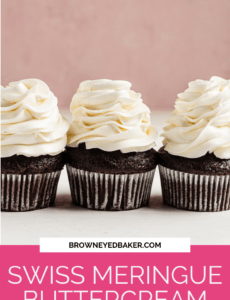



Your swiss meringue recipe makes me hugry!
Can I add 1 1/2 tsp of whipping cream & ground pistachio to this swiss buttercream? Would it make it go bad?
Hi Lily, I’m not sure what the whipping cream would do, I don’t think it’s necessary. But yes, you could fold in finely ground pistachios if you’d like.
I would also like to know, can you use cocoa powder instead of melted chocolate to make a chocolate Swiss Meringue Buttercream?
Hi Izabela, Yes you can! Once the butter and vanilla have been fully incorporated, add ¼ cup of cocoa powder. Start mixing on low speed until the cocoa powder is moistened, then increase to medium-high and beat until completely incorporated and fluffy.
I’ve never made SMBC before and was very nervous but your recipe worked like a charm. Followed the recipe and voila amazing results. Thank you so much. Your recipes have never failed for me ❤️
Have you ever used baking cocoa powder to create a chocolate flavor (instead of melted chocolate)?
I gotta make this, looks amazing!
Michael
Oooh I can’t wait to try this! I have made Italian buttercream with varying results. This looks easier.
BTW, when I mine “breaks” I use a hairdryer to warm it up while keeping the bowl on the stand mixer. Easier than the double broiler method :)
Very glad to see you are using a safe egg recipe! I will be happy to use this. Btw, your oatmeal raisin cookies are the best
Frostin sure looks pretty!
My big “goal” is to make my sister your strawberry pretzel dessert. She asked for the one from your site. I may see if she will endeavor to make this months bake along frosting lol. She is much more close to being an advanced baker like you than I am😊. You and your recipes are quite the star in our family. Nice to have this little sweet spot to have some kind moments if even just a few minutes.
I first made your strawberry Swiss butter cream a few years ago, AMAZING! I have made white chocolate and chocolate versions of this. Your best tip is to cook the sugar and egg whites until you can’t feel the sugar. My tip, after pouring the egg white mixture into your mixer, set a timer for 10 minutes and walk away. This ensures that the mixture is cool enough to start adding the butter. This is the frosting I use when making my Great Grandmothers version of a Lady Baltimore cake for my father.
Hi Terry, Thanks for the extra tips, so awesome to hear you’ve been enjoying the strawberry Swiss buttercream. And a white chocolate version would be to do for! My grandma gave me a recipe for Lady Baltimore cake, but I’ve yet to make it. Must move it to the top of my list!
Random question — where did you get the sprinkles you show on your chocolate cupcakes? So cute! Can’t wait to try this recipe — it’s been on my baking bucket list.
Hi Nicole, Do you mean these cupcakes? https://www.browneyedbaker.com/best-chocolate-cupcakes-recipe/
If so, those are simple nonpareils that you can get at most grocery stores in the baking section or, like most everything, you can get them on Amazon >> https://www.amazon.com/Wilton-710-4065-Nonpareils-Decorative-7-5-Ounce/dp/B001K7Q5PQ/ref=sr_1_4?crid=I5I13TLOKKNG&dchild=1&keywords=nonpareils&qid=1591108918&sprefix=nonpare%2Caps%2C168&sr=8-4
looking very delicious buttercream swiss.